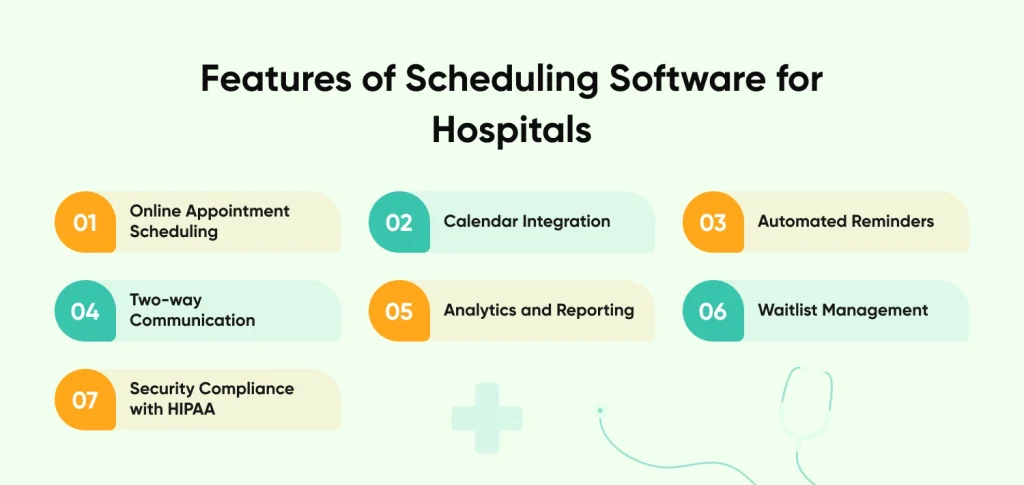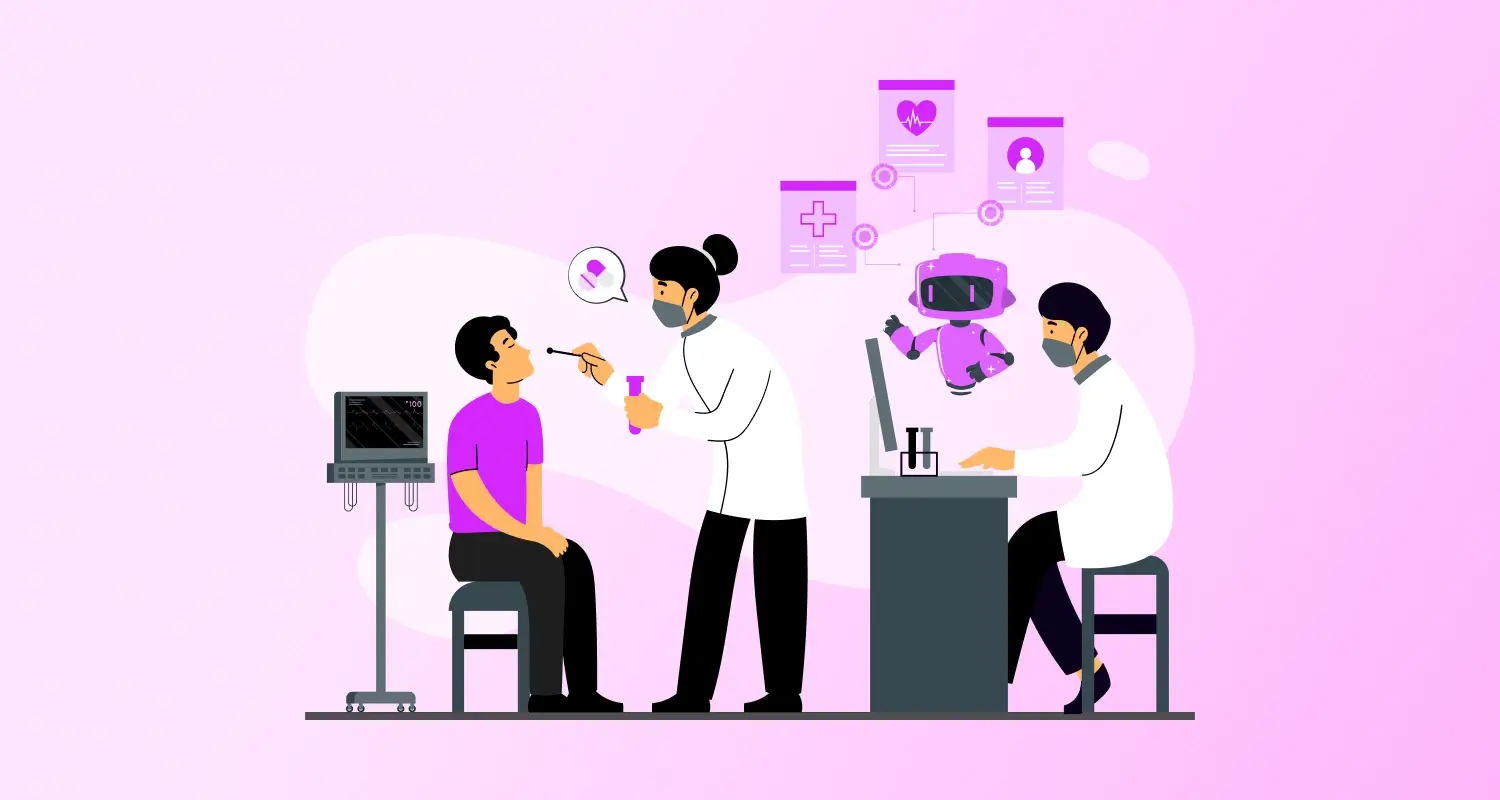Appointment scheduling software is crucial for hospitals and clinics that wish to simplify the patient experience. However, what steps are involved in creating this program, and what should come first?
Patients and medical institutions alike must benefit from the best and most effective hospital management system in the quickly expanding healthcare sector. Prolonged wait periods and difficult scheduling procedures might cause annoyance and lower patient satisfaction.
However, healthcare app development for medical scheduling is not simple. You should think about:
- Software kinds and the infrastructure they demand.
- Tech stacks needed to develop the application.
- HIPAA and other legal standards.
- User experience and accessibility; and more.
We shall examine the idea of patient scheduling software in this blog, as well as its benefits and steps to develop an effective healthcare scheduling software.
What is a Medical Scheduling Software System?
Medical professionals can assign medical staff, manage and arrange appointments, and streamline administrative procedures with the use of healthcare appointment scheduling software. Healthcare scheduling systems ensure that doctors and nurses are in the right places at the right times and that no appointments are missed.
With the use of this program, you and your employees may assign time slots in a way that minimizes wait times and avoids duplicate reservations. This solution will also be convenient for your patients because it lets you make online appointment requests and get reminders for forthcoming meetings.
Hire healthcare app developers to create a robust application for healthcare practitioners who can use software to quickly and easily allocate the required number of staff based on patient needs, saving them time and effort when dealing with paperwork to determine who visits and on what days.
Healthcare scheduling software systems perform tasks that medical staff members already perform, but more quickly and easily, freeing them up to concentrate on providing better care.
Benefits of Physician Scheduling Software
Enhanced Appointment Management
Approximately 52% of medical organizations use up valuable clinical work hours by managing appointments for 10 hours a week or more. The healthcare personnel might use that time to accomplish other important duties.
Healthcare scheduling software systems automate many laborious manual operations related to making appointments, including maintaining waitlists, delivering SMS and email reminders, and establishing appointment records. Additionally, the system can centrally store any information the doctor could need, visiting preparation much easier.
Reduces the Booking Time
Patients no longer have to wait in line or endure lengthy drives to make an appointment. They can use the patient scheduling app to browse and reserve available slots in a matter of minutes.
Accessible Remotely
Patients and medical administrators have more freedom to confirm follow-up visits without being restricted to particular places. All users have access to scheduling software for healthcare around the clock.
Minimizes Human Error
Software for automated scheduling avoids mistakes and double bookings, which costs healthcare providers money.
Gives Thorough Information
Medical scheduling systems give doctors access to a wealth of patient data for the best possible care. Scheduling software can be integrated with current platforms in real-world applications to compile electronic health records that show past patient trips.
Increases Output
Medical staff can work together more effectively and eliminate tiresome manual labor by adopting automated scheduling tools and going paperless. Nurses, for instance, don’t need to manually coordinate their shift management. Enhanced patient care, lower operating costs, and higher revenue growth, also help the medical facility.
Features of Scheduling Software for Hospitals

Healthcare scheduling software may have different characteristics, however, most healthcare web development or apps have elements that are necessary for automated appointment scheduling.
1. Online Appointment Scheduling: The program allows users to safely arrange appointments online through a patient-facing portal. Updates on real-time availability avoid double bookings, giving patients and healthcare providers accuracy and convenience.
2. Calendar Integration: To avoid double booking and guarantee a seamless scheduling procedure, the patient scheduling software easily interacts with the current calendars of healthcare professionals.
3. Automated Reminders: By using patient scheduling software, appointment reminders can be sent by phone, text message, or email, which lowers the number of no-shows and raises patient satisfaction.
4. Two-way Communication: This feature improves pre- and post-appointment interaction in patient scheduling software by enabling communication via secure messaging between patients and providers.
5. Analytics and Reporting: Reports on appointment trends can be produced, which will assist healthcare professionals in allocating resources more effectively and optimizing scheduling procedures.
6. Waitlist Management: Software for patient scheduling has a waitlist function that enables patients to sign up for lines at their desired times. When an appointment opens up, waitlisted individuals are swiftly notified by automated alerts, which maximizes resource usage.
7. Security Compliance with HIPAA: Ensuring patient data security and confidentiality requires strict adherence to HIPAA regulations. Vulnerabilities are found and fixed by the implementation of encryption methods and frequent security assessments.
How to Build Epic Scheduling Software for Hospitals
A methodical approach is necessary to assure the efficacy, security, and user-friendliness of patient scheduling software. The following is a step-by-step tutorial for developing patient scheduling software:
1. Establish Requirements
Work with medical experts to establish precise specifications for patient scheduling software, taking into account essential functionalities, integrations, and legal issues like HIPAA laws.
2. Create UI/UX
To create a user-friendly and intuitive interface for patient scheduling software, start with wireframes and prototypes and give accessibility and mobile responsiveness a priority.
3. Choosing Technology for Software for Patient Scheduling
For the development of patient scheduling software, select appropriate technologies, frameworks, and programming languages taking into account aspects such as scalability, security, and integration capabilities.
4. Set Up Security Measures in Place
To safeguard patient data and guarantee HIPAA compliance, put strict security measures in place in patient scheduling software. These include encryption and recurring security audits.
5. Interaction with EHR
To offer a thorough view of patient health records, and create a smooth interaction between patient scheduling software and Electronic Health Records (EHR) systems.
6. Create Appointment Scheduling Logic
Create an appointment scheduling logic in patient scheduling software that takes into account the availability of providers, the kinds of appointments, and their duration. Update this logic in real time to avoid conflicts.
7. Patient Scheduling Software Testing and Deployment
Perform thorough software testing to ensure patient scheduling software is functional, secure, and easy to use. To reduce interruption, roll out the program gradually while offering users thorough training and continuous support.

Trending Technologies for the Development of Patient Scheduling Apps
Healthcare technology trends and state-of-the-art technologies always have an impact on patient scheduling apps. The following cutting-edge technologies will influence how patient scheduling apps operate in the future:
1. Artificial Intelligence (AI):
Artificial Intelligence in the healthcare industry with automation and predictive analytics is provided by integrating AI into patient scheduling apps. By examining past data, machine learning algorithms can forecast the demand for appointments, optimize scheduling, and offer patients tailored recommendations according to their preferences.
2. Chatbots and Virtual Assistants
With the rise of patient scheduling apps, chatbots and virtual assistants driven by AI are becoming more prevalent. These chatbot applications improve the patient experience by helping patients make appointments, responding to questions, and giving them access to real-time information.
3. Blockchain Technology
This guarantees safe, unchangeable patient data storage. Blockchain-powered patient scheduling applications improve data security, interoperability, and integrity, which builds patient and healthcare provider trust.
4. Telehealth Integration
As telehealth becomes more popular, telemedicine software development is easily connecting with medical systems. This guarantees that healthcare practitioners can manage both in-person and virtual appointments inside a single system and enables patients to arrange virtual visits.
5. Mobile Health (mHealth) Solutions
As mobile devices are used more frequently, there is a greater emphasis on mHealth solutions in patient scheduling software. Mobile applications for healthcare offer real-time updates, appointment reminders, and easy access for patients and healthcare practitioners while on the go.
6. Internet of Things (IoT)
Applications for patient scheduling are integrating IoT devices to track resource availability in real-time and monitor and manage medical equipment. The efficiency of resource allocation and maintenance is improved by this link.
Software Systems For Healthcare Scheduling Examples
Buying widely available software from manufacturers is the simplest approach to putting self-scheduling into practice. Keep in mind that the features, supported platforms, and use cases of off-the-shelf software vary.
Theranest
Theranest is a complete practice management system for healthcare providers that helps to optimize medical workflows and patient care.
Goldie
The scheduling tool Goldie, originally known as Appointfix, is designed specifically for independent professionals, such as wellness consultants and therapists.
Nursegrid
With Nursegrid, a scheduling tool, nurses can use an easy-to-use calendar to organize and manage their shifts.
Conclusion
Modern healthcare relies heavily on patient scheduling software, which simplifies appointment scheduling, enhances patient satisfaction, and maximizes resource use. Healthcare providers can improve their operational efficiency and provide better patient care by utilizing trending technologies, incorporating essential features, and adhering to a methodical development process.
This can be achieved with the help of a healthcare software development company. Patient scheduling software is still essential to providing accessible, effective, and patient-centered healthcare services as the healthcare sector develops.
Frequently Asked Questions
Who Can Benefit from Using Healthcare Scheduling Software?
To make the best use of their time and resources, medical practices can use patient scheduling software to help patients self-book appointments, doctors fill their schedules, and physicians synchronize patient appointments with treatment room and physician availability.
What Features Are Typically Included in Healthcare Scheduling Software?
Distinct user interfaces for clients, administrators, and physicians.
Custom queue management system.
Multiply interactive calendar.
Integration of customer billing.
Patient booking options.
Email and SMS reminders.
Scheduling work hours.
Having the option to postpone and cancel appointments.
How Much Does Healthcare Scheduling Software Cost?
The cost of developing patient scheduling software is affected by several factors. Basic features (low complexity) include calendar management, appointment scheduling, and patient information management. Extra Features (Medium Complexity) include Patient intake forms, online appointment scheduling, text and email two-way communication tools, and appointment reminders and Dashboards for analytics and reporting.
Can Patients Book Their Own Appointments Online?
Patients can schedule their appointments using patient self-scheduling at any time of day or night without contacting the provider or making an in-person visit. There are other ways to implement this strategy, such as using patient portals, automated phone systems, and online and mobile scheduling tools.







